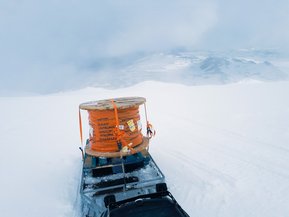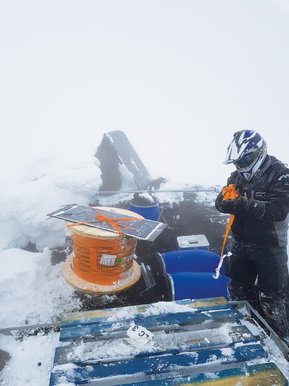Cables to crater
This year, LAPP took its cables all the way to Iceland, enabling the monitoring of one of the country’s most dangerous volcanoes. A total of 3,000 m of cable was transported through ice and snow up the slopes of the volcano – making this expedition one of our most ambitious projects yet.


Volcanoes are just as much a part of Iceland as geysers, elves and trolls. One of the country’s most active and dangerous peaks is Hekla, located in the south of the island. It erupts approximately every ten years, but since the last eruption in 2000, the volcano appears to be on a break. This is good news for tourists, but it makes geophysicists nervous. “Hekla could erupt at any minute, and the longer this quiet period goes on, the more violent the eruption will be”, warns Martin Möllhoff, geophysicist at the School of Cosmic Physics of the Institute for Advanced Studies in Dublin, Ireland. Here, Martin leads the technical division that uses seismometers to monitor countless volcanoes around the world, including Hekla.
Detecting the warning signs
Möllhoff’s team is in the process of installing six seismometers on top of Hekla. Each of these metal cylinders contains a mass made from a thermally stable metal alloy, which allows to detect movements as small as a nanometre. As Hekla offers so little warning time, it is not possible to save the measurement values and take readings on site every few months as usual. Instead, they must be communicated immediately and then relayed to the visitors on the volcano, who are alerted of any impending danger through a dedicated mobile app.
Möllhoff’s team decided to use a cable from LAPP to transfer this valuable data. The selected cable transfers data and also the energy required to run the seismometers, which is generated by three independent small wind turbines. Each wind turbine is supported by a solar cell to compensate for periods of low wind in summer, while still aiming to keep overall energy consumption as low as possible.
The cable was supplied by Johan Rönning, the market leader for electrical equipment in Iceland. Johan Rönning imports and sells LAPP products in Iceland, and supplies electrical components to most geophysical installations. The company has been working with LAPP since 1985. “We are very happy with the cooperation and they’re fantastic with delivery times”, says Óskar Gústavsson, key account manager at Johan Rönning.

Across razor-sharp volcanic rock
The main argument in favour of the LAPP cable was its robustness. The hard volcanic stone makes it impossible to install a cable underground, meaning it has to be rolled out over razor-sharp rocks. Here it has to withstand mechanical abrasion and sub-zero temperatures in the Icelandic winter. Snowfall can also occur all year round. Another important factor is heat as above the thin crust of the Mid-Atlantic Ridge the rock can be very warm. Geophysicists have measured temperatures of 50 degrees Celsius at a depth of just half a metre, while highly corrosive gases flow out of the ground across the area. On a positive note, this inhospitable landscape is not home to any voracious animals that could gnaw away at the cable!
Bergur Bergsson carried out the job of selecting the right cable for this delicate operation. The engineer from Iceland’s meteorological office went looking for a petroleum jelly-filled Ethernet cable with four twisted-pair cores, screening and a robust outer sheath. Bergsson’s colleagues have been using these cables in seismic measurement networks for 15 years, such as in a similar project on Vatnajökull, Iceland’s largest glacier.
Watertight from every angle
On the LAPP website, Bergsson found an outdoor cable for connections in telecommunication. The cable features four twisted pairs, surrounded by an aluminium-coated plastic band that acts as screening. The PE outer sheath resists UV light and is transversely waterproof, meaning that it does not allow moisture to penetrate through the sheath. If water penetrates at the ends of the cable, in this case at the connections to the seismometer and the modem in the data centre, or through a tear caused by a sharp object, the water is prevented from spreading through the cable. This is because the cable is filled with petroleum jelly.
The 60-volt direct current power supply to the seismometers is stable, as is the data transmission in both directions via separate wire pairs. This allows the volcanologists to adjust the seismometer settings from afar. The measuring system for the first installed seismometer works perfectly, collecting 1.5 gigabytes of data per month and transmitting it live to Reykjavík and Dublin.
Measurement campaign until the next eruption
So far, there is nothing to suggest that Hekla might be about to erupt. The measurement campaign is planned to continue until the next eruption occurs. The goal is to discover how imminent eruptions are reflected in the measurement data and to provide insights into developing a permanent early warning system. Such a system could then also be installed on other volcanoes. “There are still plenty of volcanoes we have not explored yet, and plenty of unanswered questions” concludes Martin Möllhoff.
The research goes on!

